Net-Zero Hero: Sebastian Casarez
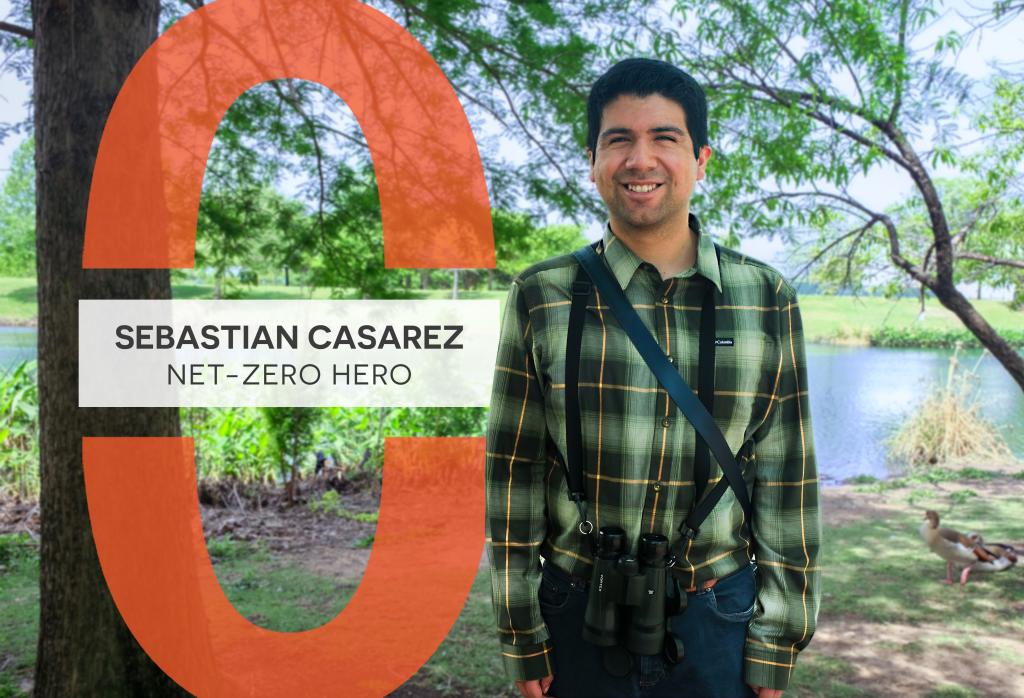
I’m helping to make Austin Net-Zero by educating communities throughout Texas and beyond about the importance of backyard birds and how to plant native plants to help birds thrive in a healthy habitat.
Meet our newest Net-Zero Hero, Sebastian Casarez! From a young age, Sebastian cultivated a deep passion for birds and birdwatching, leading him to establish The Texas Blue Jay Project. Through this initiative, he brings engaging birding presentations to rural and urban communities, distributes recycled bird field guides to schools, and helps connect young people across Texas to a love of birding. His efforts not only promote bird conservation but also encourage the planting of native plants — enhancing habitats for backyard birds and contributing to a healthier environment.
We met with Sebastian at Mueller Lake Park at the start of the peak spring migration season to discuss his journey, the impact of his work, and his vision for connecting communities to nature through birding.
What inspired you to take action?
When I was seven years old, I taught myself about birds and birdwatching by reading several bird books. My parents were not birdwatchers. Over the course of that year, I taught myself how to identify birds in my backyard without using binoculars. I studied their calls, flights, and behavior.
When my parents took me to my first community bird walk, I noticed I was the only young kid. Everyone there was either my parents or grandparents' age. The more bird walks I attended, the more I saw that there were hardly any kids my age. There is also a lack of diversity in the birding community. Birds and birdwatching are for everyone to enjoy. There should never be any obstacles for people to learn about birds and birdwatching. I was inspired to bring birding presentations to rural and urban communities across Texas and beyond.
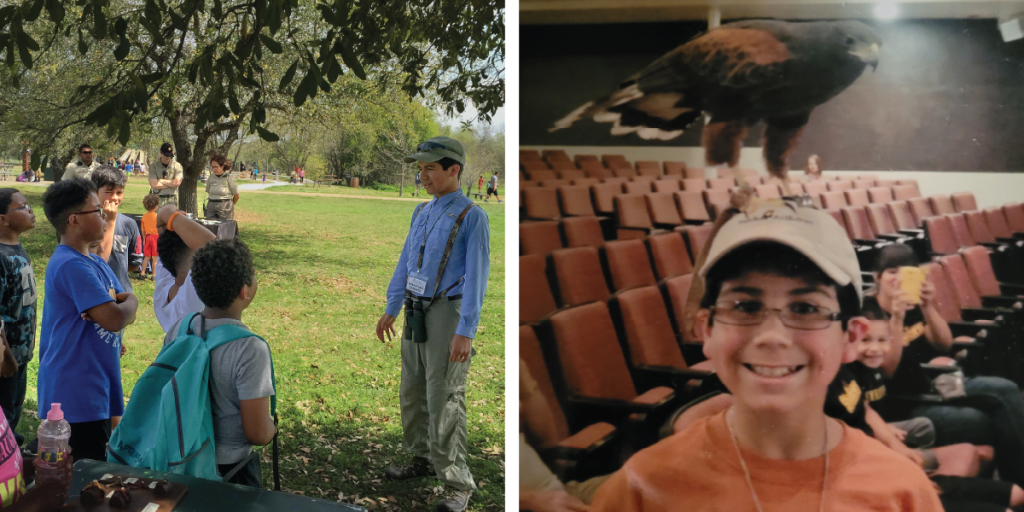
Left: Sebastian leads a birding walk for young folks. Right: Young Sebastian poses at a bird talk with a Harris’s Hawk on his head. Photos courtesy of the Casarez family.
How did you do it?
I felt motivated to share my passion for birds, birdwatching, and bird conservation with everyone. At the age of nine, I started presenting bird presentations at local community events, libraries, schools, and city and state parks. I wanted to introduce everyone to the beauty and calls of the birds in their backyards and local parks. To further connect young people to birding, I helped start the Travis Audubon Young Birders, which is still active today. In 2017, I started The Texas Blue Jay Project, which seeks to educate local communities about birds and birdwatching in their backyards and city and state parks. I also collected used bird books to donate to local schools and community centers to help promote youth birding clubs. This birding project collected and recycled used bird field guide books to distribute to the youth and teens in local communities throughout Texas.
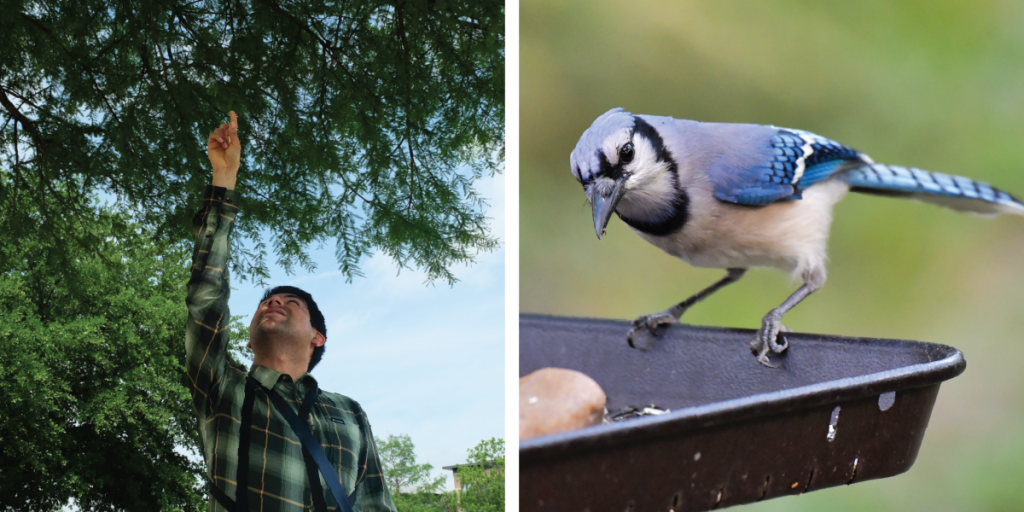
Left: Sebastian points out a Blue Jay (his favorite bird species) in a tree at Mueller Lake Park. Right: A photo of a Blue Jay courtesy of Sebastian.
I’m also working as a community scientist to help identify and count invasive bird species for The Texas Invasive Bird Project, led by Daniel Brooks at the Houston Museum of Natural Science. I heard that there have been sightings of Egyptian Geese at Mueller Lake Park, so we'll see if we can find them and record their numbers today. Invasive birds can compete with native species for resources, so it is important to monitor their populations.
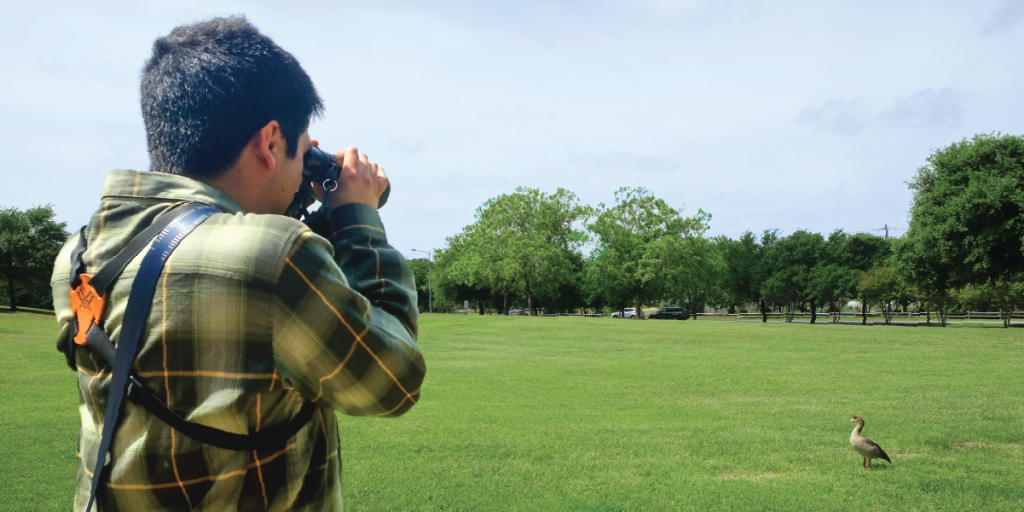
Sebastian takes a closer look at an Egyptian Goose through binoculars at Mueller Lake Park.
What’s been most rewarding about getting involved in this way?
The most rewarding thing is seeing the excitement and joy on people's faces when they identify their first backyard bird! It’s so cool to see people start noticing the birds around them. They look up at the trees when they see a bird and are trying to figure out what kind of bird it is. It’s the best reward!
Also, I enjoy their questions on what type of bird seeds to put in bird feeders and what type of native plants to have in their backyards to attract specific species, like Northern Cardinals, Hummingbirds, etc.
What’s been the toughest part?
The toughest part in teaching communities about birds, birdwatching, and bird conservation is funding. I would like to one day establish The Texas Blue Jay Project as a business. My goal is to reach every part of North America and the world about their local birds, birdwatching, and bird conservation.
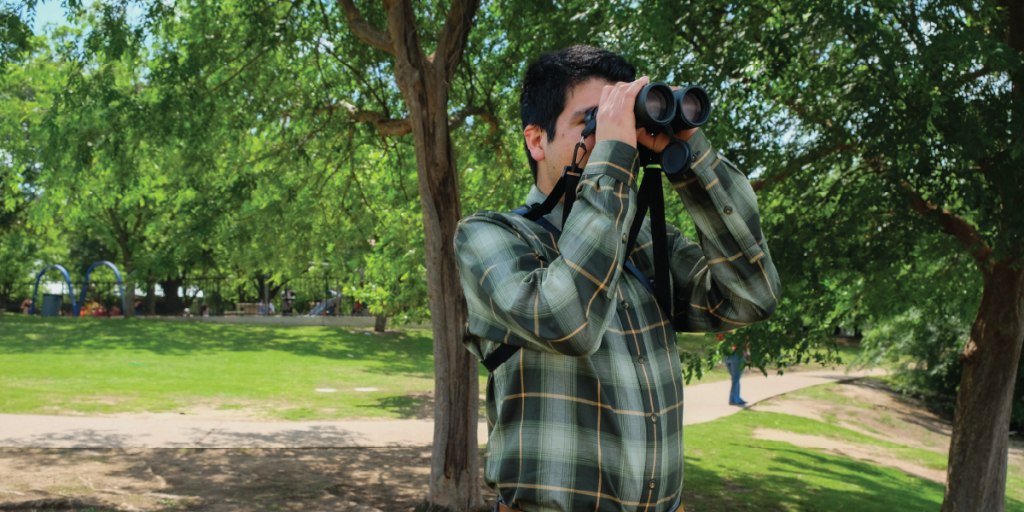
Always on the lookout, Sebastian searches for birds in the distance.
April 22 is the start of peak migration season for birds migrating through Texas. Do you have a favorite migratory bird and favorite spot to go birding in Central Texas?
My favorite spring migration bird is the endangered Golden-cheeked Warbler. My favorite birding spot in Central Texas is San Gabriel Park.
In your opinion, how can birding help people better understand and care about climate change?
When we educate and introduce people to the types of birds they have in their backyards and why birds choose to live in their backyards, people will begin to care about what type of habitat they can provide for their feathery friends. This can strengthen our outdoor spaces overall.
Also, when I work with younger kids and get them excited about the birds in their neighborhoods, my hope is that they will think about what they can do to support a cleaner environment. Maybe they will think twice about littering or take more of an interest in their local park.
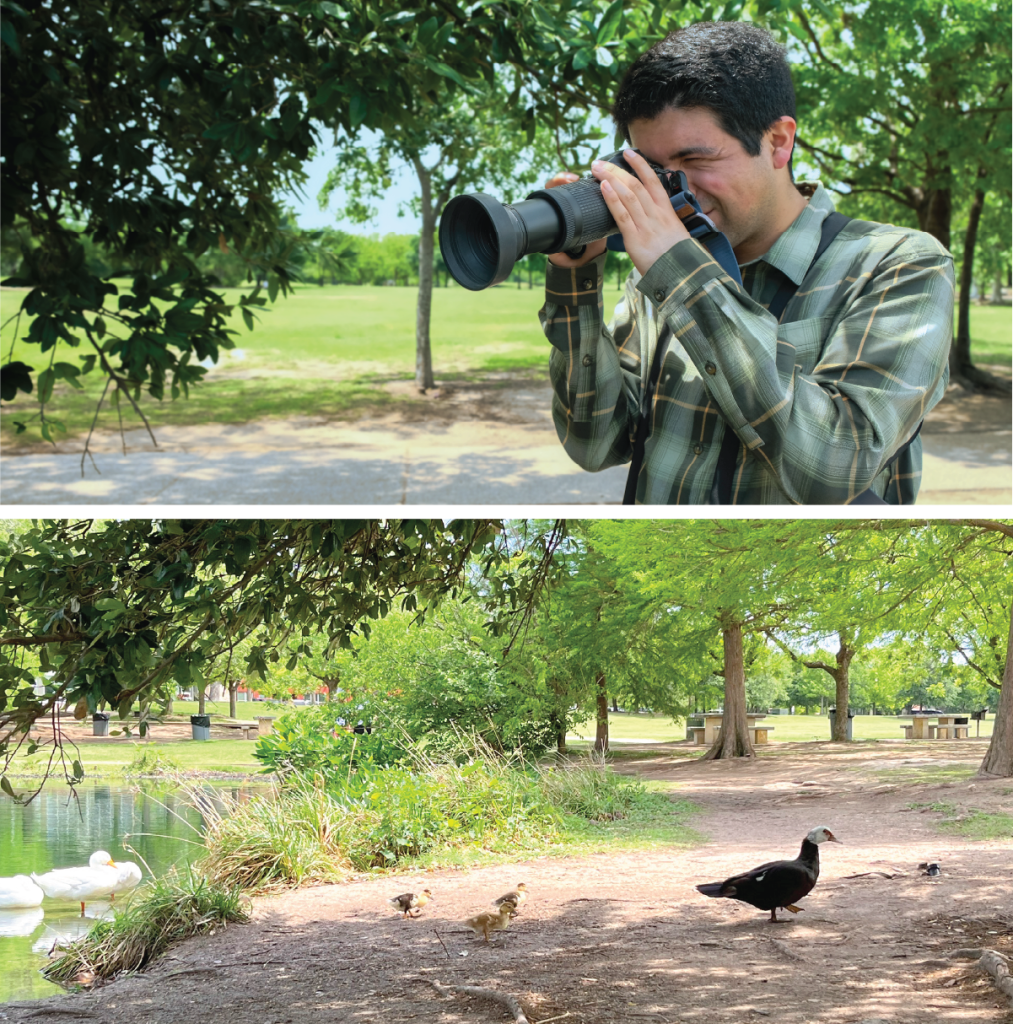
Top: Sebastian snaps a photo of a mother duck and her ducklings. Bottom: The ducklings follow their mother out of the lake.
Is there a book, documentary, or other piece of media you would recommend for folks wanting to learn more about these topics?
If you want to learn more, check out the bird field guidebook I wrote, “Common Feeder Birds of Texas” by Sebastian Casarez.
I wrote this easy-to-understand guidebook to help you identify 25 common backyard birds. You will also learn about different types of bird seeds to attract birds to your bird feeder and backyards.
I also invite people to follow me on Instagram: instagram.com/birdingaroundyourtown. I upload birding videos and share upcoming bird events.
What advice do you have for others?
I encourage everyone to share their talents to help build a stronger and better community.
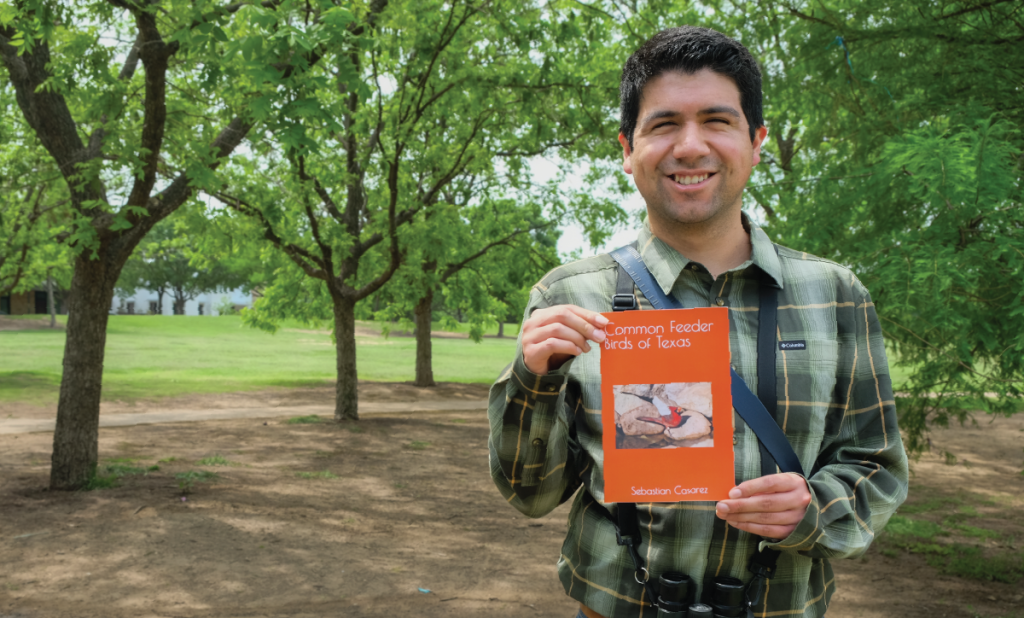
If you are interested in having Sebastian present about birds at your organization, school, or community event, he invites you to email him.
Peak spring bird migration continues until May 12. Approximately one of every three birds migrating through the U.S. this spring will pass through Texas. You can help protect migrating birds by turning off all non-essential nighttime lights from 11 pm to 6 am daily. Learn more by visiting Lights Out, Texas! To learn more about birds in our area, check out the Austin Water Wildlands Events page for information about upcoming bird walks. Travis Audubon also has many bird-related events and resources. To learn more about Austin's net-zero goal and explore actions you can take to support a greener community, view the Austin Climate Equity Plan.
Share your Net-Zero contributions with us on Facebook or X, and use #NetZeroHero. If you know a Net-Zero Hero (or heroes!) who should be recognized for their efforts, send your nomination to climate@austintexas.gov.

